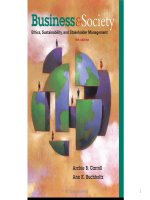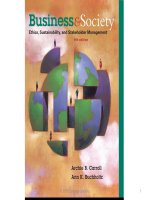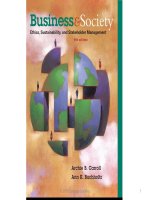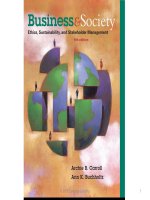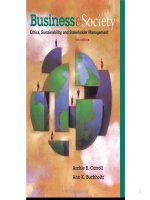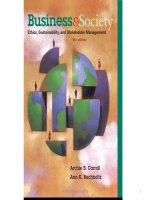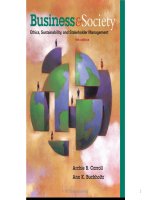Operation management 9e stevenson mcgrwhill chap006
Bạn đang xem bản rút gọn của tài liệu. Xem và tải ngay bản đầy đủ của tài liệu tại đây (348.21 KB, 55 trang )
6
Process Selection
and Facility Layout
McGraw-Hill/Irwin
Copyright © 2007 by The McGraw-Hill Companies, Inc. All
Learning Objectives
Explain the strategic importance of process
selection.
Explain the influence that process selection
has on an organization.
Describe the basic processing types.
Discuss automated approaches to
processing.
Explain the need for management of
technology.
6-2
Learning Objectives
List some reasons for redesign of layouts.
Describe the basic layout types.
List the main advantages and
disadvantages of product layouts and
process layouts.
Solve simple line-balancing problems.
Develop simple process layouts.
6-3
Introduction
Process selection
Deciding on the way production of goods or
services will be organized
Major implications
Capacity planning
Layout of facilities
Equipment
Design of work systems
6-4
Figure 6.1
Process Selection and
System Design
Forecasting
Capacity
Planning
Product and
Service Design
Technological
Change
Facilities and
Equipment
Layout
Process
Selection
Work
Design
6-5
Process Strategy
• Key aspects of process strategy
–
Capital intensive – equipment/labor
–
Process flexibility
–
Technology
–
Adjust to changes
–
Design
–
Volume
–
technology
6-6
Technology
Technology: The application of scientific
discoveries to the development and
improvement of products and services and
operations processes.
Technology innovation: The discovery and
development of new or improved products,
services, or processes for producing or
providing them.
6-7
Kinds of Technology
Operations management is primarily
concerned with three kinds of technology:
Product and service technology
Process technology
Information technology
All three have a major impact on:
Costs
Productivity
Competitiveness
6-8
Technology Competitive
Advantage
Innovations in
Products and services
Cell phones
PDAs
Wireless computing
Processing technology
Increasing productivity
Increasing quality
Lowering costs
6-9
Technology Acquisition
Technology can have benefits but …
Technology risks include:
What technology will and will not do
Technical issues
Economic issues
Initial costs, space, cash flow, maintenance
Consultants and/or skilled employees
Integration cost, time resources
Training, safety, job loss
6-10
Process Selection
Variety
Batch
How much
Flexibility
What degree
Volume
Job Shop
Repetitive
Expected output
Continuous
6-11
Process Types
Job shop
Small scale
Batch
Moderate volume
Repetitive/assembly line
High volumes of standardized goods or services
Continuous
Very high volumes of non-discrete goods
6-12
Figure 6.2
Product and Service
Processes
Process Type
Job Shop
Appliance repair
Emergency
room
Ineffective
Commercial
baking
Batch
Classroom
Lecture
Automotive
assembly
Repetitive
Automatic
carwash
Continuous
(flow)
Ineffective
Steel Production
Water purification
6-13
Product – Process Matrix
Figure 6.2 (cont’d)
Dimension
Job variety
Very High
Moderate
Low
Very low
Process
flexibility
Very High
Moderate
Low
Very low
Unit cost
Very High
Moderate
Low
Very low
Volume of
output
Very High
Low
High
Very low
6-14
Product and Process Profiling
Process selection can involve substantial
investment in
Equipment
Layout of facilities
Product profiling: Linking key product or service
requirements to process capabilities
Key dimensions
Range of products or services
Expected order sizes
Pricing strategies
Expected schedule changes
Order winning requirements
6-15
Automation
Automation: Machinery that has sensing
and control devices that enables it to
operate
Fixed automation
Programmable automation
6-16
Automation
• Computer-aided design and
manufacturing systems (CAD/CAM)
• Numerically controlled (NC) machines
• Robot
• Manufacturing cell
• Flexible manufacturing systems(FMS)
• Computer-integrated manufacturing (CIM)
6-17
Facilities Layout
Layout: the configuration of
departments, work centers, and
equipment, with particular emphasis on
movement of work (customers or
materials) through the system
Product layouts
Process layouts
Fixed-Position layout
Combination layouts
6-18
Objective of Layout Design
1. Facilitate attainment of product or service
quality
2. Use workers and space efficiently
3. Avoid bottlenecks
4. Minimize unnecessary material handling costs
5. Eliminate unnecessary movement of workers
or materials
6. Minimize production time or customer service
time
7. Design for safety
6-19
Importance of Layout
Decisions
Requires substantial investments of
money and effort
Involves long-term commitments
Has significant impact on cost and
efficiency of short-term operations
6-20
The Need for Layout Decisions
Inefficient operations
For Example:
High Cost
Bottlenecks
Changes in the design
of products or services
Accidents
The introduction of new
products or services
Safety hazards
6-21
The Need for Layout Design
(Cont’d)
Changes in
environmental
or other legal
requirements
Changes in volume of
output or mix of
products
Morale problems
Changes in methods
and equipment
6-22
Basic Layout Types
Product layouts
Process layouts
Fixed-Position layout
Combination layouts
6-23
Basic Layout Types
Product layout
Layout that uses standardized processing
operations to achieve smooth, rapid, highvolume flow
Process layout
Layout that can handle varied processing
requirements
Fixed Position layout
Layout in which the product or project
remains stationary, and workers, materials,
and equipment are moved as needed
6-24
Product Layout
Figure 6.4
Raw
materials
or customer
Station
1
Station
Station
22
Station
Station
33
Material
Material
Material
Material
and/or
labor
and/or
labor
and/or
labor
and/or
labor
Station
Station
44
Finished
item
Used for Repetitive or Continuous Processing
6-25
